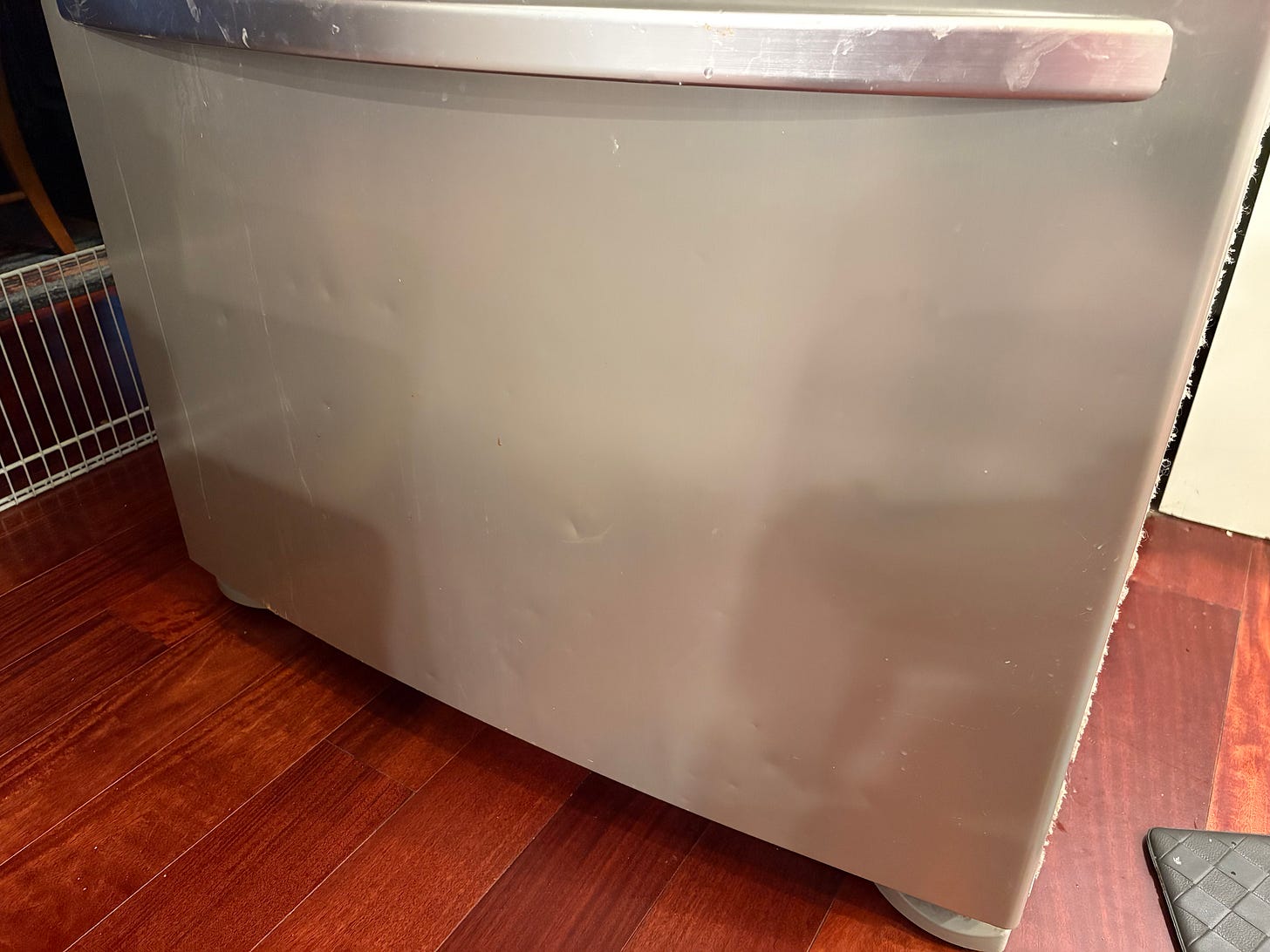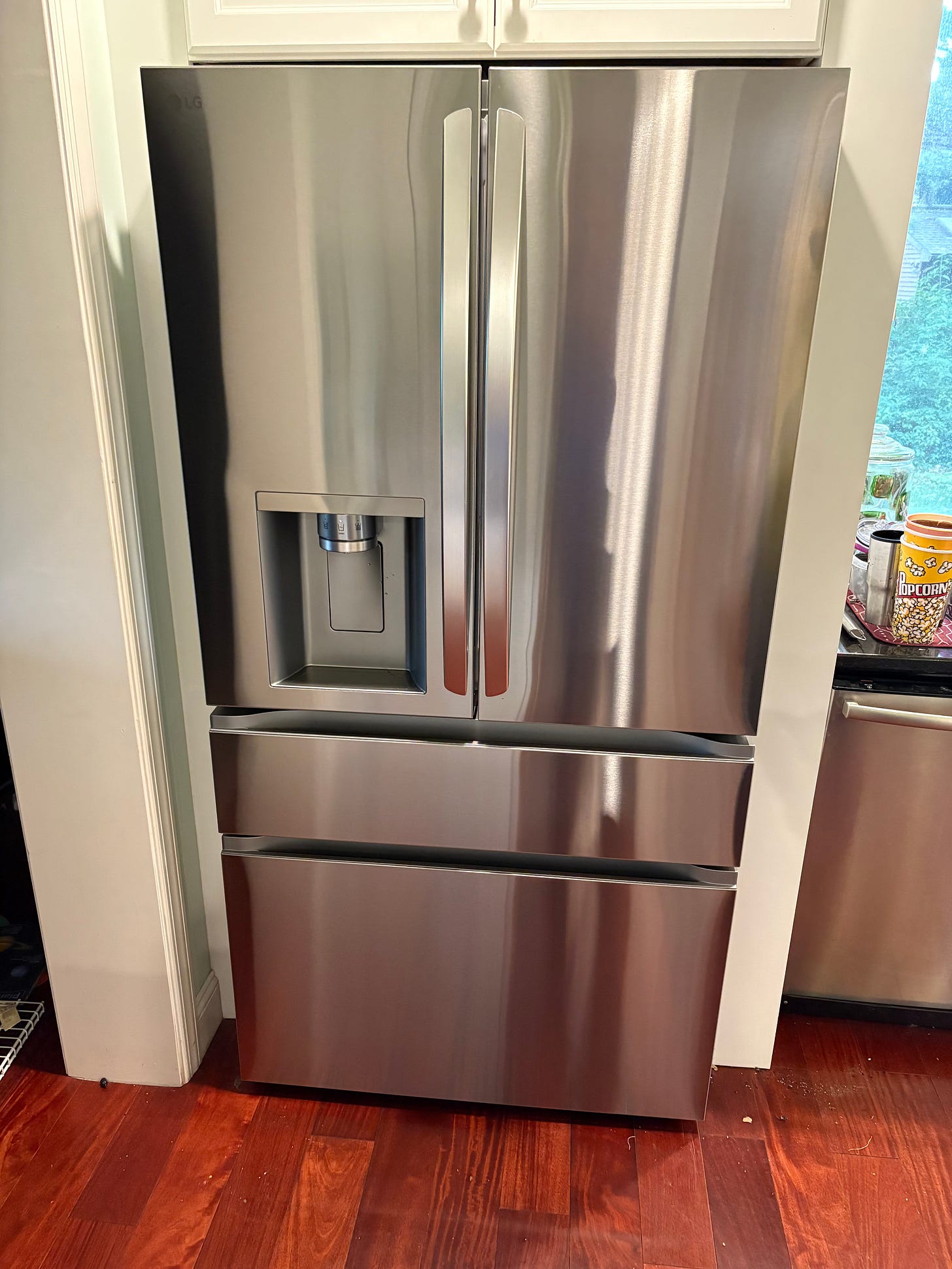The Refrigerator, the Dent, and Everything It Held
The fridge gave out. So did a few illusions.
It wasn’t supposed to be about the fridge.
It was Father’s Day, and our day already promised overloaded: head north to get Cary to Rider University for Boys State—0730, military time—then drive south to Delaware to move Lee into his new college apartment. But before any of that, the refrigerator flatlined.
The smell was... undeniable. We woke up, way too early, to a shallow layer of swampy melt that had collected at the bottom of the freezer. Everything inside was thawing, sweating through plastic and cardboard like it knew time was up. The fridge wasn’t faring any better—milk warm, greens limp, cheeses soft at the edges.
The signs had been there for a while. The ice maker only worked when it felt like it for the past few months. Shelves have been cracking for years, held together with super glue and hockey tape. And now, with summer approaching, there was no cold.
We needed a new fridge, and we’ve been ignoring that fact out of loyalty to what was lost.
This wasn’t just me hanging on. We all were. Not out loud, but there was a kind of gravitational pull to that appliance. Letting it go wasn’t just about the money. It was about what it had come to represent.
Craig and I bought it in the oughts, during that blurry stretch when we had three kids under five. It was worthy of home-modeling magazines. French doors. Stainless steel. Solid. It was built at a time when appliances were still built to last more than eight years.
This one gave us sixteen years. Sixteen years of supplying snacks, rebounding after big spills and bearing the weight of overloaded shelves after BJ’s runs.
But what made it ours, in the end, was the dent.
Ravi made it within the first few days of its arrival. He was about five, tearing around the kitchen on his plastic motorcycle trike. We were annoyed—briefly—because it was a new fridge, and there was this giant ding in the door that could not be banged out.
But we got used to it, got attached to it. The dent became part of the kitchen, part of the house, part of the past.
And after Ravi died, it became untouchable.
The double move
And now it was time to let go—not just of the fridge. We didn’t even go home after dropping Cary off.
We left him at Boys State—our liberal, 17-year-old son who’s never once had to say “Sir, yes sir”—marching off into a weeklong immersion in military-style leadership. I’m sure it’ll be good for him, maybe even eye-opening. But it’s not exactly his native language. I stood there watching him disappear into formation, already missing him.
Then, without pause, we drove straight to Home Depot.
It was still early—barely 10 a.m.—and we were standing in the fridge aisle. The old-school appliance guy gave us the full tour, showing off models with touchscreens, glowing panels, and those doors-within-doors kinds that let you grab the milk without opening the whole fridge. But when it came down to which ones last, he pointed to the most basic models—freezer up top. No bells. No panels. Just quiet, durable workhorses that don’t match modern kitchens—but tend to outlast them.
We couldn’t even go that way. They don’t make them to fill a full-sized kitchen.
After dropping nearly $3,000 on the appliance and what seems like a necessary warranty plan, we were off to Newark, Delaware, to help Lee settle into his new apartment.
This was nothing like the shotgun-shack, sloped-floor rentals Craig and I lived in during our college days. It is clean and modern. There is a washer-dryer in the unit. There is a real bedframe. And a stainless steel fridge so sleek and humming I felt an irrational pang of envy just looking at it, with the smell of our fridge’s melty demise still clinging to my clothes.
So yes, the fridge broke. But so did the illusion that we’re still in the thick of parenting.
No sendoff. Just sludge.
We made do for a few days before the new one arrived—the basement beer fridge was repurposed. The overflow food was assigned to our cooler, which was kept somewhat cold by ice packs on rotation from the garage Westinghouse freezer I inherited from my grandmother (the one appliance in this family that may actually outlive us all).
There was no ceremonial last clean-out. No final moment to acknowledge what had been. When the delivery guys came to haul it out, it leaked sludge that looked like it came from a toxic waste site.
There’s no denying that new fridge is beautiful. Water and ice actually work. It’s got that au courant middle drawer that chills wine and beer—or can be toggled into a freezer or pizza-box storage if needed. It fits the space like it always belonged there, like nothing had changed.
It’s bigger too—29 cubic feet, the kind of capacity that would have been a gift back when we had three boys always hungry, always looking for ways to feed their growing bodies.
I felt no joy stocking it with the pared-down survivors of the old fridge. Too clean. Too empty.
And still, when I walk into the kitchen, I find myself glancing toward the spot where the dent used to be. Like a phantom limb, part of me expects to see it.
Here’s what I’m starting to understand: the things I’ve clung to in grief—Ravi’s electric toothbrush I still use, the patchwork quilt made from his t-shirts that I wrap around myself while watching TV, the broken refrigerator—none of it is him.
They remind me he mattered. That he was here. That his energy once flew through this house like joy on a plastic motorcycle trike. As the years wear on, it feels harder to hold onto those memories, which I suppose is why we’re so resistant to let go.
But Ravi’s energy is not in any of those things. It’s in me. It’s in the way I still see his smile everywhere. In the way that everything I write somehow turns into keeping his memory alive. It’s in the way I love the ones still here.
I don’t need the dent to remember him. He’s with me. Always.
But still, I miss the dent.



